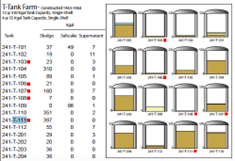Earlier this month, the U.S. Department of Energy and the Washington Department of Ecology announced an agreement, which begins to address two of Hanford’s leaking tanks, B-109 and T-111. The agreement made headlines, but does it make real progress?
Tank Leaks Show Additional Resources Needed at Hanford
Earlier this month, the U.S. Department of Energy (Energy) and the Washington Department of Ecology (Ecology) announced an agreement, which begins to address two of Hanford’s leaking tanks, B-109 and T-111. The agreement made headlines, but does it make real progress?
The B-109 and T-111 Tank Leak Problem
Tanks B-109 and T-111 contain some of the most toxic, radioactive substances on Earth, and they are leaking this high-level waste into the soil beneath Hanford. The tanks contain large quantities of radioactive cesium, strontium, plutonium, and other contaminants.
The agencies have been aware of the potential for leaks for years, but the recent discovery of additional leaking tanks compounds the problem and demonstrates the need for urgent action to address existing—and to prevent future—leaks. The agencies have not yet come to an agreement about how to build new, compliant tanks that could help to address the problem of high-level waste leaking from aging, failing tanks. Because existing double-shell tank capacity is limited and still awaiting treatment, Ecology is working with Energy to resolve the tank waste storage issue.
The problem in the leaking tanks is extremely challenging because of the high levels of radioactivity in the tank waste and the waste’s complex physical and chemical characteristics—dynamics which are not fully understood. A 1997 tank waste characterization report for Tank B-109 concluded, “Tank 241-B-109 is considered safe and does not require resampling.” Decades later, in January 2022, Energy described the B-109 tank in its Hanford Waste Management Units Report, “There is disparity between sources for tank inventories. One source lists sludge for the total waste volume at 8,000 gallons (30,280 L) of drainable interstitial liquid. Another source reports the waste comprises 30,000 gallons (113,550 L) of unknown waste…There have been no samples taken of the tank waste.”
Like tank B-109, tank T-111 contains huge amounts of radioactive sludge, all of it related to decades of processing irradiated nuclear fuel to make plutonium for nuclear weapons. The tank sits among others in the same group that have leaked in the past. The most recent tank farm summary depicts the current status of the T-tank farm (the red dots indicate 5 tanks that are assumed to or confirmed to have leaked in the past, or are actively leaking. T-111 is the only actively leaking tank in T-Farm):
Energy’s tank waste status report demonstrates that there are multiple tanks that are either assumed to have or confirmed to have leaked clustered in the same area.
Agreement Makes Very Limited Progress
The agreement regarding B-109 and T-111 reflects a commitment by Energy and Ecology to continue working towards tank waste removal, but the agreement also makes clear that tanks will leak for years.
Here is a summary of some of the key points:
- The tanks will continue to leak for years. The plan will not immediately stop ongoing leaks out of the tanks, but the agencies hope to evaluate and reduce further leaks into tanks (unsound tanks can fill with liquid even as they leak other materials that exacerbate the problem). The agencies also propose to develop a Single-Shell Tank (SSTs) Leak Response Plan, which will address future leaks from SSTs.
- Energy and Ecology plan to develop and implement a temporary surface barrier for the entire B and T tank farm areas by 2028.
- Energy and Ecology agreed to negotiate new deadlines to remove contamination “at the earliest practicable time.”
- The agencies committed to evaluate whether accelerating actual removal of tank waste from these tanks is possible. In the meantime, the tanks will release highly radioactive material into Hanford’s soil.
- The pollution will ultimately reach the Columbia River in future decades unless it is removed from soil and/or groundwater.
Leaking tanks are a symptom of a larger problem: Hanford cleanup is lagging behind the progress needed to avert worsening contamination as structures age and leak. In August of 2022, hundreds of Columbia Riverkeeper members and supporters called on Energy to avert delays and efficiently execute cleanup in Hanford’s most polluted area, the Central Plateau. We also joined with the States of Oregon and Washington and community organizations calling on the federal government to fully fund Hanford cleanup. Without adequate funding, tank waste issues and other aging infrastructure problems on site will become more dangerous and difficult as additional tanks fail.
This product is funded through a Public Participation Grant from the Washington State Department of Ecology. The content was reviewed for grant consistency but is not necessarily endorsed by the agency.
Water's Walk Through Hanford
Follow the path of a water droplet flowing through the Hanford site. Youth-friendly. Artistic. Accessible.



